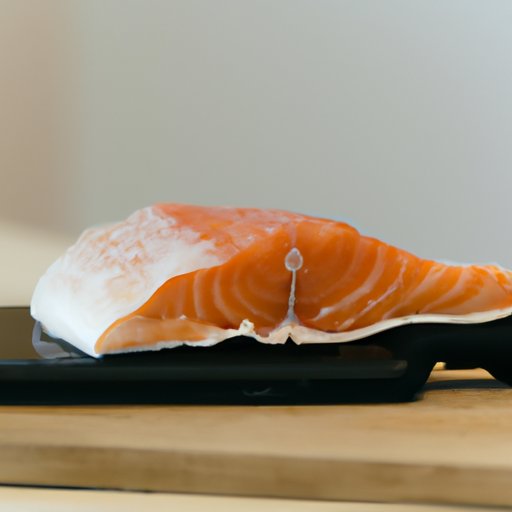
Introduction
Salmon is a healthy and delicious protein option that is loved by many. However, a common problem that people face when cooking salmon is not knowing when it is done. Overcooked salmon is dry and tough, while undercooked salmon is unsafe and unappetizing. In this article, we’ll explore several techniques to help you know when your salmon is perfectly cooked.
The Poke Test
The Poke Test is a popular technique used to determine if salmon is adequately cooked. To perform this test, take a sharp knife and poke the thickest part of the salmon. If the salmon is done, it will feel firm, but still have some give. Additionally, the salmon should separate into flakes when pulled apart.
To use this technique effectively, be mindful of the size of the salmon. If it is a whole salmon, use a long knife and insert it into the thickest part of the flesh. If it is a fillet, poke the thickest part of the fillet.
The Color Test
Another technique for determining if salmon is cooked is the color test. Cooked salmon should lose its translucent appearance and become opaque. You can use a fork to separate the flesh, which should flake easily. The color of the meat varies depending on the species, but generally, it should be pink on the inside and browned on the outside.
When using this technique, make sure to check the thickest part of the salmon for doneness. Also, be mindful of the color of the flesh and look for a consistent opaque color.
The Temperature Test
The temperature test is the most accurate way to determine if salmon is done. The appropriate internal temperature for cooked salmon is 145°F (63°C). Use a meat thermometer to take the temperature by inserting it into the thickest part of the fillet or whole salmon without touching the bone.
When using this technique, make sure to calibrate your meat thermometer to ensure accuracy. Insert it into the thickest part of the flesh without touching the bone or skewering through the entire thickness of the salmon.
The Timing Test
Timing is a crucial factor in salmon cooking. Cooking time depends on the thickness of the fish and the oven temperature. A general rule of thumb is to cook salmon for about 12-15 minutes per inch of thickness, with an oven temperature of 375°F (190°C).
When using this technique, factor in the type of oven and altitude, as both can affect cooking time. Adjust cooking time accordingly and check doneness using the Poke or Temperature test.
The Flake Test
The Flake Test is another effective way to determine if salmon is done. Take a fork and gently press into the thickest part of the salmon. Try to flake the flesh apart. If the fish easily separates into flakes, it is done. If it is still translucent and difficult to separate, it needs more cooking time.
When using this technique, be gentle with the fish to avoid overcooking or damaging the flesh.
The Touch Test
The Touch Test is another technique for determining if salmon is done. First, touch the salmon to determine its raw texture. The flesh should be springy to the touch and have some give. When it’s done, the flesh should be firm, but still have some give and resilience.
When using this technique, take care not to overcook the salmon. The longer it cooks, the firmer and tougher it becomes.
The Juice Test
The Juice Test is another technique for determining if salmon is done. After cooking, cut into the thickest part of the salmon and observe the juices. If the liquid is clear, the salmon is done. If the juices are pink, the salmon needs more cooking time. Additionally, you can use a fork to gently separate the meat; it should flake easily.
When using this technique, make sure to cook the salmon until it is opaque, and the internal temperature is 145°F. This will decrease the likelihood of underdone salmon.
Conclusion
Learning how to cook salmon perfectly will come with time and practice. The Poke, Color, Temperature, Timing, Flake, Touch, and Juice Tests are useful techniques to determine if salmon is adequately cooked. Try out these techniques to find the one that works best for you. Don’t forget to adjust cooking times based on the thickness of salmon and the oven’s temperature, and be mindful of using an accurate meat thermometer. With these tips in mind, you’ll be sure to cook perfectly done and delicious salmon every time.





